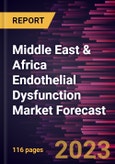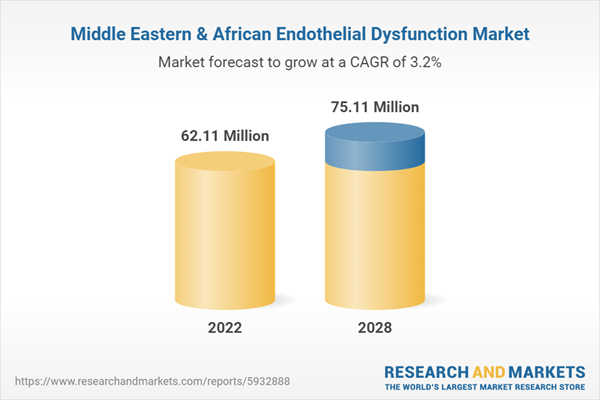The Middle East & Africa endothelial dysfunction market is expected to grow from US$ 62.11 million in 2022 to US$ 75.11 million by 2028. It is estimated to grow at a CAGR of 3.2% from 2022 to 2028.
Noninvasive methods for assessing endothelial function are mainly used in scientific research since there is a significant risk of complications due to the specificity of endovascular interventions. One of the noninvasive methods to assess endothelial function is to measure fluorescence. Flow-mediated skin fluorescence (FMSF) is based on the fluorescence measurement of the reduced nicotinamide adenine dinucleotide (NADH) emitted by skin cells in response to UV light excitation. The test consists of three phases: recording the fluorescence's background intensity, occlusion phase, and reaction registration. FMSF allows the determination of tissue and vascular bed response during ischemia, while classical Flow-Mediated Dilatation (FMD) techniques are based on a study of vasomotor reactivity. The classic FMD method for assessing the intensity of reactive hyperemia comprises three phases: measurement of the diameter of a selected artery (e.g., brachial artery), stimulation phase, and measurement after stimulation. Reactive peripheral arterial hyperemia tonometry (RH-PAT) is a modified FMD method used in EndoPAT devices. The method has been extensively validated in numerous publications as a diagnostic and predictive tool for assessing vascular risk. The closed zone FMD method (EZ-FMD) is based on oscillometric blood pressure measurement.
Based on cause, the Middle East & Africa endothelial dysfunction market is segmented into hypertension, hypercholesterolaemia, obesity, diabetes, behcet's disease, and others. The hypertension segment registered the largest Middle East & Africa endothelial dysfunction market share in 2022.
Based on test type, the Middle East & Africa endothelial dysfunction market is segmented into invasive test and non-invasive test. The invasive test segment held a larger Middle East & Africa endothelial dysfunction market share in 2022. The non-invasive test segment is further subsegmented into flow mediated dilatory, peripheral arterial tonometry (PAT), venous occlusion pletismography, circulating markers, and others.
Based on end user, the Middle East & Africa endothelial dysfunction market has been categorized into hospitals, diagnostic centers, clinics, and others. The hospitals segment held the largest Middle East & Africa endothelial dysfunction market share in 2022.
Based on country, the Middle East & Africa endothelial dysfunction market is segmented into the UAE, Saudi Arabia, South Africa, and the Rest of Middle East & Africa. The Rest of Middle East & Africa dominated the Middle East & Africa endothelial dysfunction market in 2022.
ZOLL Medical Corp, The Polymath Co, Perimed AB, SMART Medical Ltd, and Medizinische Messtechnik GmbH are some of the leading companies operating in the endothelial dysfunction market in the region.
Use of Non-invasive Methods to Assess Endothelial Dysfunction Fuels Middle East & Africa Endothelial Dysfunction Market
Endothelial dysfunction is a strong prognostic factor for cardiovascular events and mortality in the population. Assessment of endothelial function can aid in selecting therapies and assessing their response. While invasive angiography remains the gold standard for measuring coronary endothelial function, several noninvasive imaging techniques have evolved to study both coronary and peripheral endothelial function. Available endothelial testing methods are helpful for mechanistically understanding diseases and risk stratification and prognoses, such as high-resolution B-mode ultrasound and Doppler, computed tomography angiography, cardiovascular magnetic resonance (CMR), magnetic resonance imaging (MRI), and positron emission tomography (PET).Noninvasive methods for assessing endothelial function are mainly used in scientific research since there is a significant risk of complications due to the specificity of endovascular interventions. One of the noninvasive methods to assess endothelial function is to measure fluorescence. Flow-mediated skin fluorescence (FMSF) is based on the fluorescence measurement of the reduced nicotinamide adenine dinucleotide (NADH) emitted by skin cells in response to UV light excitation. The test consists of three phases: recording the fluorescence's background intensity, occlusion phase, and reaction registration. FMSF allows the determination of tissue and vascular bed response during ischemia, while classical Flow-Mediated Dilatation (FMD) techniques are based on a study of vasomotor reactivity. The classic FMD method for assessing the intensity of reactive hyperemia comprises three phases: measurement of the diameter of a selected artery (e.g., brachial artery), stimulation phase, and measurement after stimulation. Reactive peripheral arterial hyperemia tonometry (RH-PAT) is a modified FMD method used in EndoPAT devices. The method has been extensively validated in numerous publications as a diagnostic and predictive tool for assessing vascular risk. The closed zone FMD method (EZ-FMD) is based on oscillometric blood pressure measurement.
Middle East & Africa Endothelial Dysfunction Market Overview
Middle East & Africa consists of countries such as Saudi Arabia, the UAE, South Africa, and the Rest of Middle East. The growth of the market is attributed to increasing cases of chronic diseases that are primary factors or endothelial dysfunction, growing collaborations between governments to enhance healthcare facilities in South Africa, and growing incidences of obesity.Middle East & Africa Endothelial Dysfunction Market Revenue and Forecast to 2028 (US$ Million)
Middle East & Africa Endothelial Dysfunction Market Segmentation
The Middle East & Africa endothelial dysfunction market is segmented into cause, test type, end user, and country.Based on cause, the Middle East & Africa endothelial dysfunction market is segmented into hypertension, hypercholesterolaemia, obesity, diabetes, behcet's disease, and others. The hypertension segment registered the largest Middle East & Africa endothelial dysfunction market share in 2022.
Based on test type, the Middle East & Africa endothelial dysfunction market is segmented into invasive test and non-invasive test. The invasive test segment held a larger Middle East & Africa endothelial dysfunction market share in 2022. The non-invasive test segment is further subsegmented into flow mediated dilatory, peripheral arterial tonometry (PAT), venous occlusion pletismography, circulating markers, and others.
Based on end user, the Middle East & Africa endothelial dysfunction market has been categorized into hospitals, diagnostic centers, clinics, and others. The hospitals segment held the largest Middle East & Africa endothelial dysfunction market share in 2022.
Based on country, the Middle East & Africa endothelial dysfunction market is segmented into the UAE, Saudi Arabia, South Africa, and the Rest of Middle East & Africa. The Rest of Middle East & Africa dominated the Middle East & Africa endothelial dysfunction market in 2022.
ZOLL Medical Corp, The Polymath Co, Perimed AB, SMART Medical Ltd, and Medizinische Messtechnik GmbH are some of the leading companies operating in the endothelial dysfunction market in the region.
Table of Contents
1. Introduction
3. Research Methodology
4. Middle East & Africa Endothelial Dysfunction Market - Market Landscape
5. Middle East & Africa Endothelial Dysfunction Market - Key Market Dynamics
6. Endothelial Dysfunction Market - Middle East & Africa Analysis
7. Middle East & Africa Endothelial Dysfunction Market Analysis - by Cause
8. Middle East & Africa Endothelial Dysfunction Market Analysis - by Test Type
9. Middle East & Africa Endothelial Dysfunction Market Analysis - by End User
10. Middle East & Africa Endothelial Dysfunction Market - Revenue and Forecast to 2028 - Country Analysis
11. Middle East & Africa Endothelial Dysfunction Market-Industry Landscape
12. Company Profiles
13. Appendix
List of Tables
List of Figures
Executive Summary
At 3.2% CAGR, the Middle East & Africa Endothelial Dysfunction Market is Speculated to be Worth US$ 75.11 million by 2028.According to this research, the Middle East & Africa endothelial dysfunction market was valued at US$ 62.11 million in 2022 and is expected to reach US$ 75.11 million by 2028, registering a CAGR of 3.2% from 2022 to 2028. Increasing incidences of cardiovascular diseases and rising incidences of high cholesterol, diabetes and obesity are the critical factors attributed to the Middle East & Africa endothelial dysfunction market expansion.
According to the World Health Organization (WHO), cardiovascular diseases (CVDs) are among the leading causes of death worldwide, and ~30 million people experience a stroke each year. CVDs include cerebrovascular disease, coronary heart disease, rheumatic heart disease, and coronary artery disease (CAD). CAD is the most common disease among all cardiovascular diseases, and it is characterized by the accumulation of lipids and immune cells in the subendothelial space of the coronary arteries or atherosclerosis. It involves the inflammatory response of the vascular endothelium. CAD is characterized by ischemia, hypoxia, or necrosis of the myocardium resulting from narrowing, spasm, or obstruction of the coronary artery lumen by atherosclerosis. It has become the leading cause of death worldwide.
According to the World Heart Federation, cardiovascular disease is the primary cause of death in the Middle East & North Africa, accounting for more than a third of all deaths or 1.4 million people annually. Further, CVD deaths have increased by 48% over the past 30 years, which accounted for 40% and 10% of deaths in Oman and Somalia, respectively. In 2021, age-standardized CVD mortality rates in the Middle East & North Africa ranged from 134.2 to 600.2 per 100,000 people.
Therefore, the high prevalence of cardiovascular diseases due to endothelial dysfunction drives the market.
On the contrary, disadvantages associated with the techniques for screening of endothelial dysfunction hurdles the growth of Middle East & Africa endothelial dysfunction market.
Based on cause, the Middle East & Africa endothelial dysfunction market is segmented into hypertension, hypercholesterolaemia, obesity, diabetes, behcet's disease, and others. The hypertension segment held 32.7% share of Middle East & Africa endothelial dysfunction market in 2022, amassing US$ 20.33 million. It is projected to garner US$ 25.29 million by 2028 to expand at 3.7% CAGR during 2022-2028.
Based on test type, the Middle East & Africa endothelial dysfunction market is segmented into invasive test and non-invasive test. The invasive test segment held 74.0% share of Middle East & Africa endothelial dysfunction market in 2022, amassing US$ 45.98 million. It is projected to garner US$ 54.83 million by 2028 to expand at 3.0% CAGR during 2022-2028. The non-invasive test segment is further subsegmented into flow mediated dilatory, peripheral arterial tonometry (PAT), venous occlusion pletismography, circulating markers, and others.
Based on end user, the Middle East & Africa endothelial dysfunction market has been categorized into hospitals, diagnostic centers, clinics, and others. The hospitals segment held 52.0% share of Middle East & Africa endothelial dysfunction market in 2022, amassing US$ 32.32 million. It is projected to garner US$ 39.86 million by 2028 to expand at 3.6% CAGR during 2022-2028.
Based on country, the Middle East & Africa endothelial dysfunction market has been categorized into the UAE, Saudi Arabia, South Africa, and the Rest of Middle East & Africa. Our regional analysis states that the Rest of Middle East & Africa captured 27.5% share of Middle East & Africa endothelial dysfunction market in 2022. It was assessed at US$ 17.07 million in 2022 and is likely to hit US$ 19.54 million by 2028, exhibiting a CAGR of 2.3% during 2022-2028.
Key players operating in the Middle East & Africa endothelial dysfunction are ZOLL Medical Corp, The Polymath Co, Perimed AB, SMART Medical Ltd, and Medizinische Messtechnik GmbH, among others.
In April 2023, Perimed has signed an agreement with Lovell Government Services. Lovell’s customers are Federal, State, and Local Governments such as the Department of Veteran Affairs (VA), Defense Logistics Agency, and Department of Defense in the United States. With this agreement, Perimed gains an additional sales channel as Lovell will notify the company of any government contract opportunities within its field of business and bid on Perimed’s behalf.
Companies Mentioned
- Medizinische Messtechnik GmbH
- Perimed AB
- SMART Medical Ltd
- The Polymath Co
- ZOLL Medical Corp
Table Information
| Report Attribute | Details |
|---|---|
| No. of Pages | 116 |
| Published | December 2023 |
| Forecast Period | 2022 - 2028 |
| Estimated Market Value in 2022 | 62.11 Million |
| Forecasted Market Value by 2028 | 75.11 Million |
| Compound Annual Growth Rate | 3.2% |
| Regions Covered | Africa, Middle East |
| No. of Companies Mentioned | 5 |









